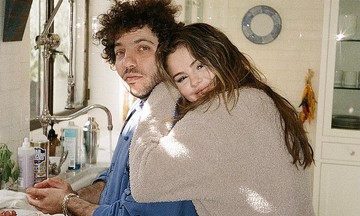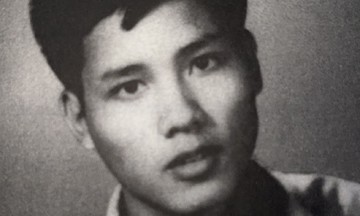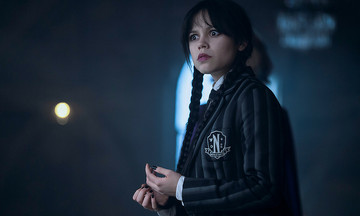After two weeks in theaters, the film shows no signs of slowing down, becoming a box office phenomenon and capturing public attention. During the three years of production, the team dedicated themselves to reflecting a part of the fierce battle at the Quang Tri Citadel.
According to director Dang Thai Huyen, the film features fictional characters and details but draws inspiration from real events and people. "We didn't focus too much on individualizing the characters but wanted them to embody the shared characteristics of people from that era. Those who lived through the war may see themselves reflected in the film, while younger generations can glimpse their ancestors. In war, specific individuals become immortal, and they all merge into one great monument," the director said.
Writer Chu Lai penned the script in 2010 at the suggestion of a businessman whose older brother, Cuong, was a martyr at Quang Tri. The businessman said, "Write a screenplay for me to send to my son, who is studying directing abroad. Maybe someday he can make it into a film, or if not, at least he'll understand more about his uncle who sacrificed his life." The main character of "Mua do" was also named Cuong. Chu Lai added details such as Cuong being a conservatory student skilled in martial arts.
To gather material, Chu Lai drove from North to South Vietnam, interviewing witnesses in many provinces. He stayed in Quang Tri for over a week, interacting with veterans, guerrillas, and locals. Some nights, he went to the citadel to listen for the "whispers of comrades" beneath the earth.
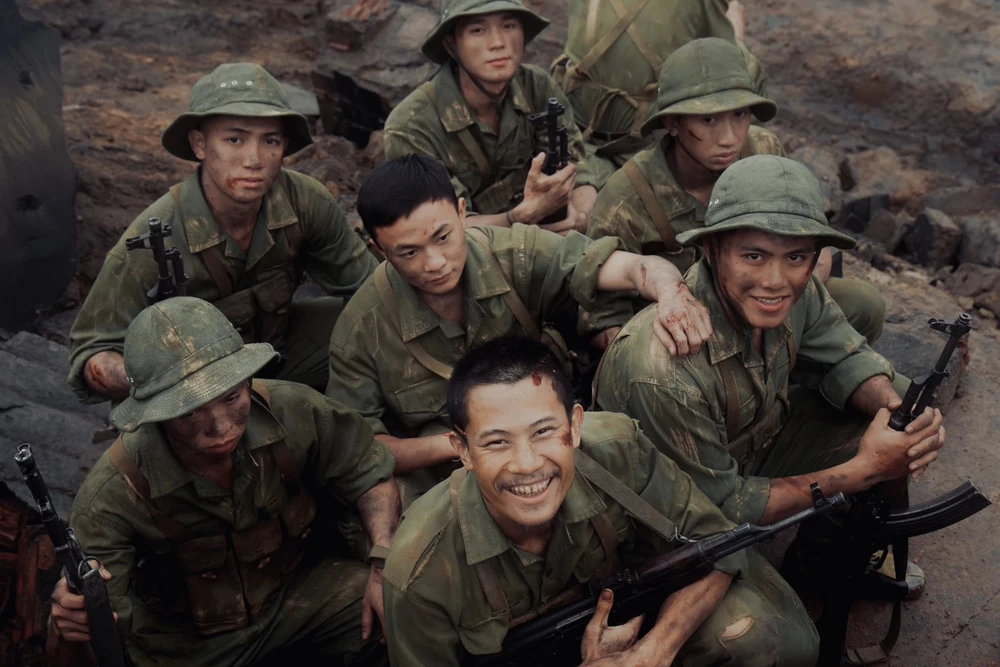 |
The cast of "Mua do". Photo: Provided by the film crew |
The character Cuong joins the K3 - Tam Son squad, inspired by Battalion K3 - Tam Dao, a main force unit that participated in the battle. They were famous for the saying, "While K3 - Tam Dao remains, the Citadel remains." In the film, the characters say, "While K3 - Tam Son remains, the Citadel remains." According to Nguyen Van Hoi, 77, Head of the K3 - Tam Dao Battalion Liaison Board, the unit initially had 325 members, later receiving reinforcements four times over, but in the end, only 39 survived.
O Hong, the ferrywoman who transported soldiers across the river, is notable for her love story with the main character, Cuong. In real life, guerrilla Nguyen Thi Thu performed this duty. At 18, shortly after her engagement ceremony, the fighting at the citadel intensified. She and her father-in-law, Nguyen Con, ferried troops across the river daily. Nguyen Con, a renowned local fisherman, knew every bend and current of the river.
Thu recounted how whenever artillery shells rained down on the river, the soldiers would lie on top of her and her father-in-law to shield them. They said they had to protect the ferry operators at all costs to maintain the supply line of weapons, ammunition, and personnel. Photographer Doan Cong Tinh captured an image of Thu and her father-in-law, which is now displayed at the Quang Tri Citadel Museum. In 2007, after 35 years, Doan Cong Tinh finally located the subjects of his photograph. Poet Le Ba Duong, author of the verse: "Ferry on Thach Han, oh... row gently/ Beneath the river lie my friends/ At twenty, they became waves/ Soothing the shore, forevermore", also joined the trip to visit Thu.
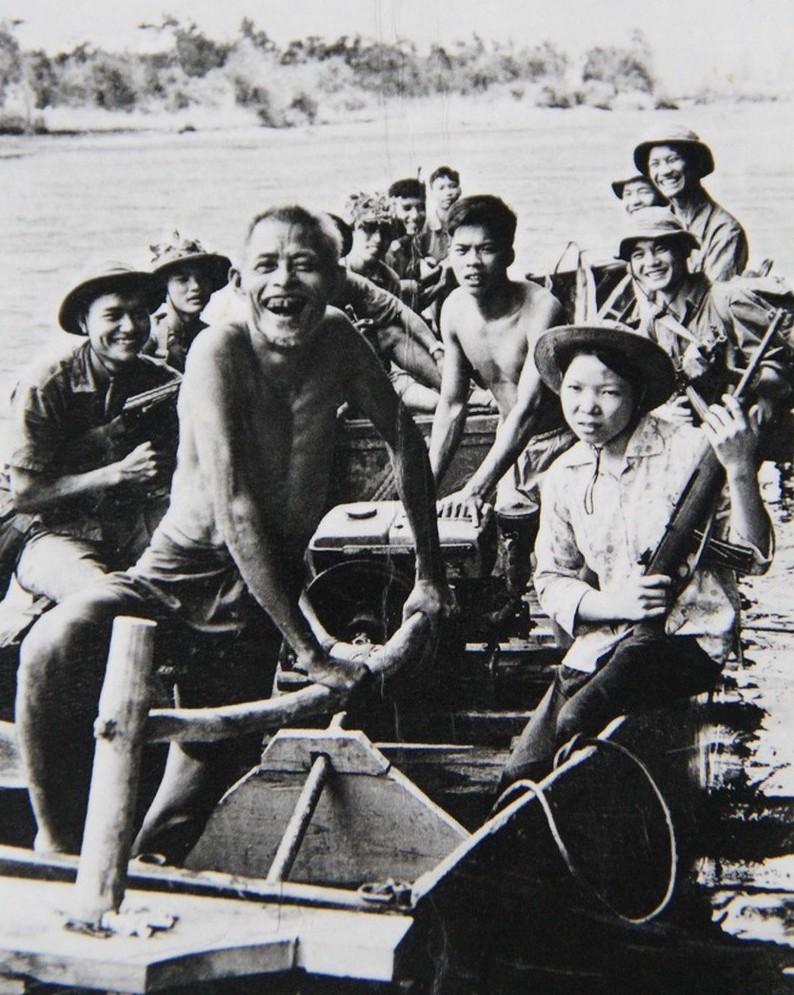 |
Thu (right) and her father-in-law (left) ferrying soldiers across the river, in a photograph by Doan Cong Tinh. Photo: Archive |
In recent years, with Doan Cong Tinh's advancing age, only Le Ba Duong continues his annual visits to Thu. At 71, Thu lives with her husband and suffers from various age-related ailments. They still cherish mementos like the photograph and notes from Doan Cong Tinh.
The Thach Han River, the site of fierce naval battles, is mentioned in many details. Upon first reading the script, director Dang Thai Huyen wept, contemplating the soldiers' sacrifices on the river.
Nguyen Van Hoi, a veteran of the citadel, recalled the reality of that time: "There were days when the Command announced they would send the battalion 50-70 new recruits. Each soldier was given a 2.5-meter raincoat to wrap their belongings and rifle. We waited from night until near dawn and saw a few buoys surface. My comrade and I were overjoyed and about to jump out of the trench to welcome them, but a barrage of artillery fire rained down on them. Adrift on the Thach Han River, only the cries of 'Mother!' and 'Sister!' remained. They were so young, they hadn't even known love." Dang Thai Huyen incorporated this haunting image into the film, leaving a lasting impression on many viewers.
In "Mua do," before his death, the character Ta (played by Phuong Nam) tremblingly pulls money from his pocket and asks Cuong to pay his Party dues. Colonel Dao Van Phe, Deputy Head of the K3 - Tam Dao Battalion Liaison Board and one of the witnesses who worked with the film crew, confirmed this detail's authenticity. However, the event didn't occur during the Quang Tri Citadel battle but in 1968 during the fight for Hill 689. Before his death, martyr Nguyen Xuan Khoat took money from his pocket and asked a comrade to pay his Party dues to the company's political officer.
The scene of Ta writing a letter to his family also moved many viewers to tears. During the battle, thousands of such letters were sent, connecting the front lines with those at home. Among them, martyr Le Van Huynh's letter, which remained in Quang Tri, is now displayed in the museum.
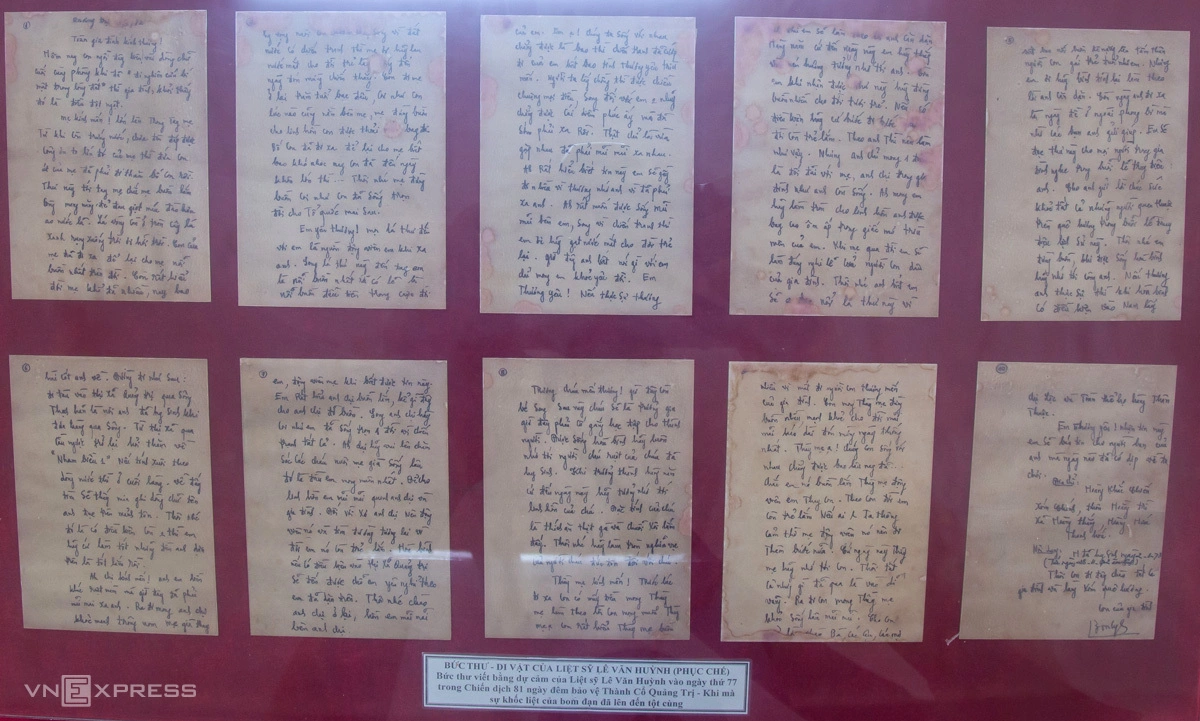 |
The letter of martyr Le Van Huynh displayed at the Quang Tri Citadel. Photo: Hoang Tao |
Dated 11/9/1972, the 77th day of the 81-day battle, the letter begins: "To my beloved family! I sit here writing these last few lines in case I go to research secrets in the earth, so the family won't be surprised." In 10 pages, Huynh expressed his love for his mother, wife, and relatives, sensing this would be his final letter. He also entrusted his nephew to remember his fallen uncle.
The letter details his unit's location, where he anticipated his death and burial. He instructed his wife: "When peace comes, if possible, come and retrieve my remains. Take the train to Quang Tri city, cross the Thach Han River, where I fell. From Quang Tri city, cross the bridge back towards Nhan Bieu 1; if you follow the river's flow, it's at the end of the village. Search there, and you'll find my name etched on a piece of sheet metal."
Before Huynh could send his letter, he died. His comrades later sent his belongings home, but his body remained in Quang Tri.
In the film, Tan has to eat live snakes to survive. The soldiers shared every drop of water and handful of rice. In the final days, as the trenches flooded, they tied themselves to posts so they wouldn't drift away if they dozed off. Many suffered from scabies, lice, and malaria. These details are all based on real accounts from veterans.
Produced by the People's Army Cinema, "Mua do" boasts high-quality content and visuals that evoke strong emotions. The script follows the events of the 81-day battle to defend the citadel. Chu Lai chose to focus on the human element, specifically a small squad of young soldiers from three regions of Vietnam.
The film received substantial investment from pre-production, featuring grand sets and large-scale battle scenes. The producers haven't disclosed the investment amount, but many estimate the film's budget reached hundreds of billions of dong. The crew built a 50-hectare film set on the banks of the Thach Han River. During filming, the crew utilized modern equipment and lighting. The director of photography used up to seven cameras for many scenes.
The central character is Cuong (played by Do Nhat Hoang), a spirited and skilled martial artist from the music conservatory. He abandons his opportunity to study abroad to enlist in the army. During the fighting in Quang Tri, Cuong fights alongside his squad, including Ta, the squad leader, Binh, Tu, Hai, and Sen. They come from different backgrounds and have distinct personalities but share the same goal of fighting for peace.
Ha Thu






